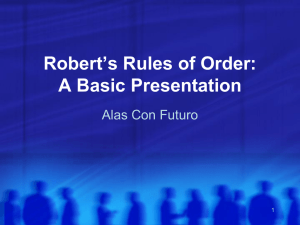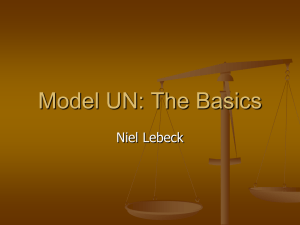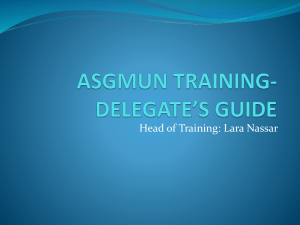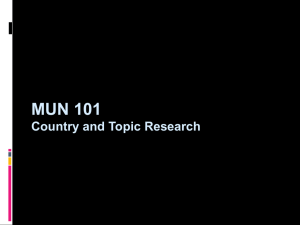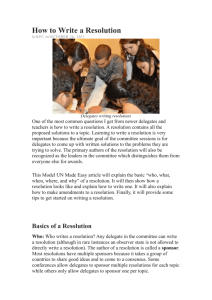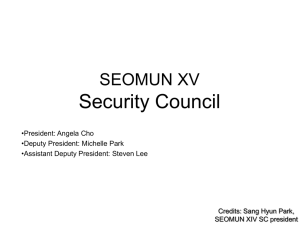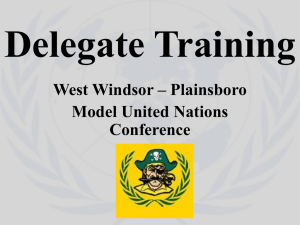Parli Pro and Resolution Writing
advertisement
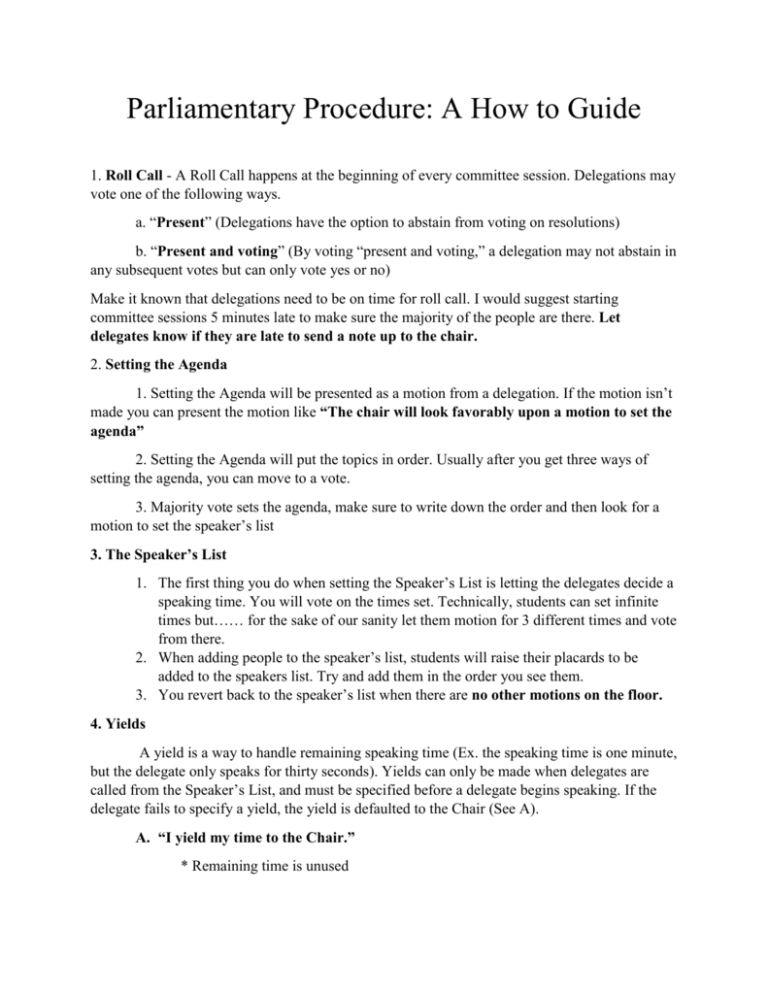
Parliamentary Procedure: A How to Guide 1. Roll Call - A Roll Call happens at the beginning of every committee session. Delegations may vote one of the following ways. a. “Present” (Delegations have the option to abstain from voting on resolutions) b. “Present and voting” (By voting “present and voting,” a delegation may not abstain in any subsequent votes but can only vote yes or no) Make it known that delegations need to be on time for roll call. I would suggest starting committee sessions 5 minutes late to make sure the majority of the people are there. Let delegates know if they are late to send a note up to the chair. 2. Setting the Agenda 1. Setting the Agenda will be presented as a motion from a delegation. If the motion isn’t made you can present the motion like “The chair will look favorably upon a motion to set the agenda” 2. Setting the Agenda will put the topics in order. Usually after you get three ways of setting the agenda, you can move to a vote. 3. Majority vote sets the agenda, make sure to write down the order and then look for a motion to set the speaker’s list 3. The Speaker’s List 1. The first thing you do when setting the Speaker’s List is letting the delegates decide a speaking time. You will vote on the times set. Technically, students can set infinite times but…… for the sake of our sanity let them motion for 3 different times and vote from there. 2. When adding people to the speaker’s list, students will raise their placards to be added to the speakers list. Try and add them in the order you see them. 3. You revert back to the speaker’s list when there are no other motions on the floor. 4. Yields A yield is a way to handle remaining speaking time (Ex. the speaking time is one minute, but the delegate only speaks for thirty seconds). Yields can only be made when delegates are called from the Speaker’s List, and must be specified before a delegate begins speaking. If the delegate fails to specify a yield, the yield is defaulted to the Chair (See A). A. “I yield my time to the Chair.” * Remaining time is unused B. “I yield my time to questions.” * Chair will call on a delegate to ask the speaker a question. Speaker can only respond for the amount of time unused. No back-and-forth dialogue between delegates! C. “I yield my time to [insert country’s name here].” * If a delegate (Oman) yields the remainder of their time to another country (Yemen), that country must accept the yield. * The country yielded to (Yemen) cannot make another yield (NO DOUBLE YIELDS). 5. Points Points give delegates a voice about administrative matters not related to the substance of the committee. 1. Point Of Order Tool to point out a discrepancy in parliamentary procedure or another delegate’s actions Ex. “Point of Order? The delegate is discussing resolution 3, but only 1 and 2 have been presented.” 2. Point of Personal Privilege Ex. “Point of Personal Privilege? Can the Dais please speak up? We can’t hear the Chair in the back.” 3. Point of Parliamentary Inquiry Tool to ask the Dais to clarify a motion made, a vote up for consideration, or any other step of parliamentary procedure Ex: “Point of Parliamentary Inquiry? Are we voting on Resolution 1.2 or 1.4?” 6. Caucusing 1. Moderated Caucus The moderated caucus allows countries that are low on the Speaker’s List to have the opportunity to speak by temporarily suspending the Speaker's List and allowing the chair to call on countries at their discretion. The delegate who proposed the caucus should specify the topic of discussion, specify the duration (not to exceed 20 minutes), and speaking time per delegate. To signal your desire to speak, simply raise your placard. Delegates should remain in their seats during a moderated caucus and maintain decorum, as during formal debate. SAY: “Motion for a ten-minute moderated caucus with 30-second speaking times [for the purpose of discussing __________________].” 2. Unmoderated Caucus A motion for an unmoderated caucus, which requires a majority to pass, allows the suspension of the rules and of formal debate. Delegates may leave their seats and discuss topics freely. The delegate making the motion must specify a total time for the proposed caucus, not to exceed 20 minutes. The Chair reserves the right to rule such a motion out of order. This is an ideal time to draft resolutions and develop relationships with fellow countries. SAY: “Motion for a ten-minute unmoderated caucus.” 7. Resolution Each delegation can sponsor or sign as many resolutions as they wish Sponsors are countries who agree with the content of the resolution or draft and intend to support it. Signatories are countries who would like to see the draft debated but do not necessarily support all the elements of the resolution. A signatory of a resolution does not have to vote in favor of the resolution. Each resolution requires at least 2 sponsors. Both resolutions and amendments alike require a simple majority to pass. Amendments Friendly amendments: - Approved by all sponsors of the resolution Automatically added without a vote as soon as they are submitted to the Dais Unfriendly amendments: Presenting a Resolution 12.5%+1 of the committee as sponsors/signatories before being presented to the Chair Require two speakers for and two speakers against and a majority vote before being added to the draft resolution 1. Suspension of the rules at Chair’s discretion. This means that you are able to present the resolution in whatever way seems most effective to your students. 2. All the sponsors read the resolution to the committee. If there are a lot of sponsors bring up the top 5. This is essentially your decision so whatever causes the least chaos. 3. Allow five minute for Q&A 7. Voting Straw Poll • A non-binding poll vote on a draft resolution or resolution that allows delegates to get a feel for the popularity of an issue. Moving into Voting Procedure Sounds like “Motion to close debate.” [Conference Note: DO NOT ALLOW if the group as a whole has not come to some kind of consensus] - Once the body has voted affirmatively to close debate, the committee immediately moves into voting procedure - No one may enter or leave the room and advisor cannot enter Voting Procedure 1. 2. 3. 4. 5. Each resolution is voted on in the order that it was presented (Resolution 1.1, 1.2, etc.) Voting on unfriendly amendments occurs before voting on the resolution as a whole Each resolution is passed by a simple majority May vote yes, no, yes with rights, no with rights, abstain, or pass Voting with rights means that a delegation is voting contrary to its expected vote based on its declared foreign policy. Delegations voting with rights may give a speech at the conclusion of voting giving their reasoning for such a vote. It is not suggested that you vote with rights; rather, vote according to policy! 6. If a delegation passes, it will be called on again when all other countries have voted. Motions Specific to Voting “Motion for a roll call vote.” “Motion to reorder the resolutions.” “Motion to divide the question.” Basics of a Resolution Who: Who writes a resolution? Any delegate in the committee can write a resolution (although in rare instances an observer state is not allowed to directly write a resolution). The author of a resolution is called a sponsor. Most resolutions have multiple sponsors because it takes a group of countries to share good ideas and to come to a consensus. Some conferences allow delegates to sponsor multiple resolutions for each topic while others only allow delegates to sponsor one per topic. What: What is a resolution? A resolution is a document that contains all the issues that the committee wants to solve and the proposed solutions to that issue. It’s called a resolution because that’s what the United Nations calls the documents they produce (here are some real 2011 Security Council resolutions). Technically, the resolution should be called a draft resolution before it is voted upon and then called a resolution after it is successfully passed during voting bloc. When/Where: When and where are resolutions written? Most conferences require students to write resolutions during the conference. Specifically, resolutions are usually written during unmoderated caucus (sometimes called informal caucus) where delegates are free to roam around the committee to collaborate on ideas with each other, and sometimes students work outside in hallways or computer labs as well. Resolution-writing becomes more focused during the latter sessions of committee when different country policies are clear and different ideas have been mentioned already. These conferences will not allow any pre-written resolutions. A few conferences have “docket-style” debate. This is when students are required to submit resolutions to the conference in advance and the chairs pick the best ones and put them into a docket. The delegates focus only on the resolutions in the docket when they get to the conference and work on amending them. Why: The ultimate purpose of a committee session is to pass a resolution. All the speeches, debate, negotiation, and teamwork is supposed to lead up to a resolution which contains all the proposed solutions to the issue. The resolution(s) that the majority of the committee agrees upon will be passed during voting bloc and the sponsors will be informally commended for building consensus on good ideas. Most conferences allow multiple resolutions to pass as long as they do not contradict each other, but a few conferences allow only one resolution to pass. How to Write a Resolution How: how do I write a resolution and what does the format look like? First, here is an example of how a resolution looks like from UNA-USA’s website: Sample Resolution A resolution is actually really simple to write. It has three main parts: the heading, the preambulatory clauses, and the operative clauses. We’ll break down the example above into these three parts below. 1. Heading The heading contains four pieces of information: the committee name, the sponsors, the signatories, and the topic (not necessarily in that order depending on each individual conference’s rules). Resolution heading The committee name and topic should be self-explanatory. The sponsors are the authors of the resolution. The signatories are other delegates in the committee who do not necessarily agree with the resolution but would like to see it debated. Most conferences require a minimum number or percentage of sponsors and signatories (or a combination of both) before a resolution can be presented — this encourages consensus-building. You will also notice some numbering (on the top right corner in the example). This is usually provided by the committee chair and is just a way to number the different resolutions — usually by the order they are received or approved — so that delegates can easily differentiate or reference them. 2. Pre-ambulatory clauses The pre-ambulatory clauses states all the issues that the committee wants to resolve on this issue. It may state reasons why the committee is working on this issue and highlight previous international actions on the issue. Pre-ambulatory clauses can include: Past UN resolutions, treaties, or conventions related to the topic Past regional, non-governmental, or national efforts in resolving this topic References to the UN Charter or other international frameworks and laws Statements made by the Secretary-General or a relevant UN body or agency General background info formation or facts about the topic, its significance, and its impact. Resolution pre-ambulatory clauses It’s very simple to write a pre-ambulatory clauses. First, take a statement that you want to write about (perhaps an issue you want to solve or a specific fact from one of the five bullet points above). You then take that statement, combine it with an underlined pre-ambulatory phrase, and end it with a comma. Here are some example pre-ambulatory phrases from UNA-USA’s website that you can choose from: Pre-ambulatory clauses For example, my country wants to address the issue of how HIV/AIDS has spread rapidly in subSaharan Africa. I pick a pre-ambulatory phrase from above — I’ll use “Alarmed by” — and then I combine it to say: Alarmed by the 17% increase in HIV/AIDS contraction among sub-Saharan African countries in the past five years, Strategy Tip: In general, you want fewer pre-ambulatory clauses than operative clauses. More operative clauses convey that you have more solutions than you have problems. 3. Operative clauses Operative clauses state the solutions that the sponsors of the resolution proposes to resolve the issues. The operative clauses should address the issues specifically mentioned in the preambulatory clauses above it. Resolution operative clauses It’s very simple to write an operative clause. First, take a solution that you want to include in the draft resolution. You then take that solution, combine it with an underlined operative phrase, and end it with a semicolon (the last operative clause ends with a period). Operative clauses are also numbered. This differentiates them from pre-ambulatory clauses, helps show logical progression in the resolution, and makes the operative clauses easy to refer to in speeches and comments. Here are some example operative phrases from UNA-USA’s website that you can choose from: Operative clauses For example, my first solution is to distribute low-cost medicines for HIV/AIDS to sub-Saharan African countries. I pick an operative phrase from above — I’ll use “Calls upon” — and then I combine it and number it to say: 1. Calls upon the developed countries and major pharmaceutical countries to provide low-cost, generic medicines for HIV/AIDS to sub-Saharan African countries; Strategy Tip: Usually more details in an operative clause will make it stronger or at least make the idea more clear to other delegates. A simple way to strengthen each operative clause is to answer the “who, what, when, where, why, and how” of each resolution. These details can actually be broken down into sub-operative clauses underneath the main operative clause.
